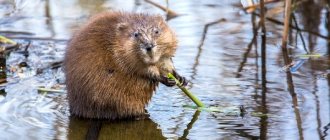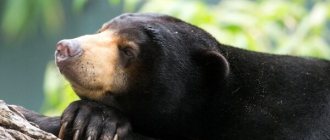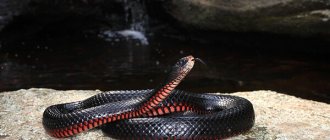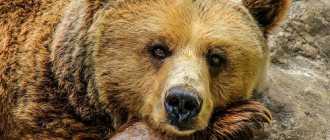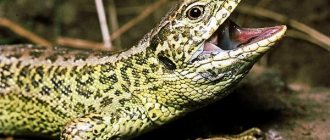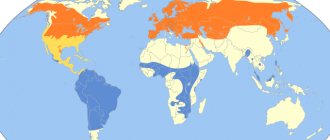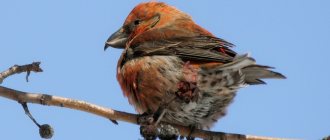The name Mednovsky Arctic fox is associated with Medny Island, located between the Pacific Ocean and the Bering Sea. The Komandorsky Nature Reserve is located throughout its entire area. It is thanks to its creation and existence that a small population of this animal species is preserved. About a hundred blue foxes live on the territory of the reserve.
In years rich in food, during the summer, quite a lot of blue foxes are born, which, due to lack of hunting experience, often fall off cliffs and die. But the main culprit in the decline in the number of these animals is still humans.
Blue Arctic fox: description and content features
Among all fur-bearing animals, the blue fox is one of the rarest in the wild. For this reason, we are not talking about any fur trade, that is, hunting, in this case. However, the blue fox is quite successfully bred in captivity, which makes it possible to obtain valuable blue fur without violating the laws on the protection of animals listed in the Red Book. Moreover, the blue fox is one of the most popular fur-bearing caged animals.
Keeping at home
For exotic lovers, you can try keeping the Arctic fox at home. It is best to keep the Arctic fox in a spacious wooden cage. If the arctic fox is small, then it is better to keep it not alone, but with its brother. You can feed the Arctic fox with food that is natural to it: meat, fish, cereals. Moreover, if in winter he does not consume a lot of food, then in the summer, when his metabolism accelerates, the arctic fox becomes a real glutton, which is not surprising, because he needs to store fat for the winter.
Who is called the blue fox?
It is important to be clear from the outset regarding the terminology used. The fact is that the term “blue fox” is not always used in the same way in different sources, and this can create some confusion.
Let's start with the fact that all representatives of the Arctic fox species are divided into two main groups - the white arctic fox and the blue arctic fox. Animals of the first group, of which the absolute majority, have classic seasonal color dimorphism: in summer their fur is dark in color, in winter it is white. In turn, blue foxes are a kind of “mutant”, since their dark summer color remains all year round. Thus, some sources apply the term “blue arctic fox” specifically to these animals, which are very rare, but are found everywhere in all populations from Scandinavia to Alaska.
In other sources, only those that live on Medny Island in the Commander Archipelago are called blue foxes. The local population, consisting of about a hundred animals, is represented entirely by arctic foxes of the second group. That is, those who wear dark fur all year round. Based on the name of the island, these animals are often called Mednovsky Arctic foxes. It is noteworthy that some sources even claim that Mednovsky Arctic foxes are white in winter and dark in summer. It is obvious that in this case there is a clear confusion of concepts about two subspecies of arctic fox.
Since the Mednovsky blue fox is simply one of the rare populations consisting entirely of the common blue arctic fox, for the purposes of this review we will use the term blue arctic fox and Mednovsky arctic fox interchangeably, since in practice there is not much difference between them.
Blue Arctic fox - photo and description
The blue arctic fox, as well as the common white arctic fox, is a small predator of the canine family and the only representative of its biological genus. Outwardly, it strongly resembles a fox, from which it differs in its smaller size and coat color. The arctic fox is also distinguished from the fox by its squat stance and shortened muzzle. The Arctic fox's ears are rounded and protrude very slightly above the general level of the winter coat, which protects them from frostbite.
The body length of an adult animal is 50-75 cm, excluding the tail, which adds another 25-30 cm to the size of the animal. The height of the Arctic fox at the withers reaches 20-30 cm. Despite its rather large dimensions, the weight of the animal is not very large: on average 3.5 kg for males and 3 kg for females.
While the white arctic fox radically changes the color of its coat in spring and autumn, the blue arctic fox remains dark all year, although it moults on schedule. In summer, the Arctic fox's fur is a dirty brown color, and in winter it ranges from sandy to dark gray and coffee brown. The name “blue arctic fox” was given to this animal because its winter fur has a beautiful bluish sheen.
The spring molt of arctic foxes starts in March-April and continues until June. In autumn, the coat change lasts from September to December. The highest quality fur of Arctic foxes is observed in the depths of winter from January to the end of February.
Arctic foxes live in open tundra, preferring hilly terrain. The animal lives in burrows, which it digs in sandy hills and coastal terraces, forming complex underground labyrinths with several entrances. In this case, the burrows are always located in relative proximity to water. Interestingly, due to the lack of suitable places in the tundra for digging holes, arctic foxes use the same dwellings for generations over tens and even hundreds of years.
Although the arctic fox is primarily a predator, its diet also contains a significant amount of plant food. However, it is based on all kinds of small rodents and birds. The animal also loves fish very much, not disdaining fish that have been washed ashore by the waves. Arctic foxes, to a certain extent, are also scavengers, often eating what is left after a polar bear's meal. Finally, the animal willingly steals hunters’ prey caught in traps and snares.
Like many other predators, the arctic fox relies more on well-developed senses of smell and hearing, and a little less on vision. The voice of this animal strongly resembles the yelp of an ordinary domestic dog puppy.
Factors that influence numbers
The number of animals directly depends on the regularity and proper nutrition. In the natural environment, the constant consumption of lemmings allows the population to increase. For animals raised in captivity, overfeeding is undesirable. Overweight Arctic foxes raised in nurseries often die.
The nomadic lifestyle also has a negative impact on numbers. Weak and hungry, Arctic foxes simply die. Often the white arctic fox becomes a victim of larger predators - foxes, wolverines, wolves, eagles. Young individuals die from parasites and infestations, while adults die from rabies and feralization. On average, Arctic foxes live from 6 to 10 years.
Features of keeping blue fox
Since the common white fox and the Mednovsky blue fox are essentially the same animal, the breeding rules for them are also the same. A farmer who intends to breed Arctic foxes in order to obtain valuable fur must thoroughly study everything related to the living conditions of this animal in the wild. A fur farm will be successful only if these features are taken into account when organizing it.
All factors are of great importance - the location of the fur farm, equipment and cages for arctic foxes, feeding characteristics, breeding of arctic foxes and raising young animals. It is equally important to understand how the laws of inheritance of fur color work in order to apply them to improve the livestock.
The production process on the arctic fox fur farm is subject to the natural cycle of the arctic fox and consists of the following periods:
After the end of lactation, the young animals are separated from the females and the whole cycle begins anew.
Place for an arctic fox farm
In the case of Arctic foxes, the same principle applies as for all other fur-bearing animals: the further north the farm is located, the higher quality fur will be obtained from the animals. Of course, the tundra zone is best suited for this, but given that more or less developed communications in this zone are only in some areas, willy-nilly, many entrepreneurs have to open fur farms south of the Arctic Circle. Meanwhile, outside the tundra zone, the quality of arctic fox fur is greatly reduced.
As for the type of terrain, any flat and dry area is suitable, preferably in an elevated place, but protected from the winds. It is optimal if there are a lot of trees and shrubs around the farm, which will not only protect the farm from the winds, but will also create a favorable environmental situation at the site.
What do Arctic foxes eat in the wild?
Snow-white predators are not at all picky in their gastronomic preferences, and feed on everything that is more or less edible. And such omnivory not only helps arctic foxes survive in the icy tundra, but also makes their dinner table very varied. The animals' diet includes protein and plant foods, as well as seafood. And of course, the animals do not disdain carrion, and without hesitation they pick up the scraps of other polar predators.
The Arctic fox had a great catch today
The arctic foxes menu includes:
- Small rodents (mainly lemmings);
- Baby seals and fur seals;
- Birds: partridges, ducks, geese, seagulls;
- Bird eggs;
- Fish;
- Molluscs, crustaceans, sea urchins;
- Berries such as cloudberries, blueberries, lingonberries;
- Bulbs and roots of plants;
- Algae (especially seaweed);
- Mushrooms;
- Moss, lichens.
The above diet is available to arctic foxes mainly during the warm season. In winter, they have to be content with the corpses of the inhabitants of the sea thrown ashore, and the remains of the meals of their four-legged neighbors.
These little animals are very enterprising and resourceful. They often destroy hunting traps and raid polar explorer camps or human settlements. Arctic foxes steal canned food and dry rations, food from dog bowls, and even grain and vegetables from barns. Furry animals also skillfully use their charm and often beg fishermen for a treat in the form of a fish or a sandwich.
Cages and houses for arctic foxes
Cages in which animals are kept should be placed at a distance of a meter from each other, and it is advisable to leave at least two meters between rows of cages for ease of maintenance. Rows of cages must certainly be protected from precipitation by a canopy. In addition, the canopy protects the animals' fur from fading under the sun.
The cages themselves for adult animals and growing young animals are made of durable mesh and raised above ground level by half a meter or a meter. The mesh on the walls may be larger, but for the floor, in any case, you should choose one with small cells so that the arctic foxes can walk on them comfortably.
Although arctic foxes live in families in the wild, in a fur farm it is still better to keep them alone. The only obvious exception is females with milk puppies. The minimum dimensions of single cells are 2-6 meters in length, 1-1.5 meters in width and 0.6-1 m in height. To save space on the farm, you can make paired cages with one adjacent wall, which is reinforced with boards. In this case, the doors are made from the opposite side.
In each cage containing an adult Arctic fox, it is necessary to provide a small house that imitates a mink or nest. The dimensions of the house must be at least 60 cm wide and 110 cm long.
Today, if you wish, you can order standard cages according to a ready-made project, without bothering with making them yourself. True, the starting costs for creating a fur farm will increase noticeably.
Social structure and reproduction
Arctic foxes are monogamous animals. They almost always form strong pairs and live in families. Each family usually includes two adults - a male and a female, their cubs of the current brood in the amount of three to ten puppies, and sometimes several more young females from the previous brood. Some animals can live in colonies of several families. Very often, females raise offspring. Sometimes two or three families can unite in neighboring burrows connected by a passage.
Typically, the area of habitat of an arctic fox family ranges from 2 to 30 square kilometers. However, in hungry years, polar foxes can run far beyond the boundaries of their territory, up to tens of kilometers.
Before having offspring, adult Arctic foxes dig minks for themselves. A place for a burrow is always chosen in elevated places, since on the plain there is a risk of flooding with melt water. Usually, burrows are dug in soft soil, among stones, which are needed for protection. A well-located burrow, suitable for breeding, can be passed on by Arctic foxes from generation to generation. But more often the old hole is abandoned by the new generation, and a new hole is built nearby. It is often connected to the parental home by a tunnel. Sometimes you can find entire labyrinths, reaching 50-60 entrances.
These animals reach sexual maturity at nine or eleven months. In March or early April, female Arctic foxes begin to estrus, which usually lasts no more than two weeks. At this time, a period called hunting takes place. During the period when the female can become pregnant, fights occur between rival males. By fighting, they draw the female’s attention to themselves. A male's flirting can also occur in another way: he runs in front of his chosen one with a stick, a bone or another object in his teeth.
Pregnancy usually lasts 52 days, but this value can range from 49 to 56 days. Towards the end, when the pregnant female feels that she will give birth soon, usually this happens within 2 weeks, she begins to prepare her home - she digs a new hole, clears the old one of leaves. If for some reason there is no hole, then she can give birth in the bushes. From the moment the female gives birth to her cubs, the male arctic fox becomes the only breadwinner for the entire family.
The female takes full care of the offspring. For about 10 weeks, small puppies feed on milk. Then, having already reached three to four weeks of age, they gradually begin to leave the hole. Their mother not only feeds them, but also teaches them to hunt, teaches them to survive frosts by digging holes in snowdrifts.
Nutrition
Since the blue fox, whose photo is presented here, comes from a region with a very cold climate, its metabolism is very fast, which is why it requires more food than other predators of a similar size. In addition, the animal’s appetites change significantly depending on the time of year.
You also need to remember that in nature, arctic foxes rush to any food they can find (which is not surprising in the harsh conditions of the tundra). In cage housing, this means there is a risk of overeating if the animals have more food than they need. Young and inexperienced individuals are especially prone to such behavior. For this reason, it is strongly recommended to strictly adhere to the optimal amount of food recommended for arctic foxes. During the day, the nutritional scheme is as follows: in the morning 30% of the daily norm, in the afternoon - 15%, in the evening - everything else.
In the warm season, the arctic fox should eat an average of about 500 g of feed every day. In winter, the animal’s appetite decreases significantly, and it can be content with only 350 grams. Moreover, in the summer, the diet should include more fats, and in winter, on the contrary, proteins, carbohydrates and vitamins.
Due to the fact that the Arctic fox is a predator, it will have to be fed with food of animal origin. Ideally, the daily balance of feed should be as follows: 400 g of meat (can be partially replaced with fish), up to 70 ml of milk, up to 150 g of vegetables and at least 70 g of cereals. Of course, vitamin and mineral mixtures should be used as supplements.
Speaking of cereal feeds. This point must not be ignored under any circumstances. Arctic foxes need to be given grains of wheat, barley, or corn. Oats, millet and sunflower seeds will also work. However, the latter can only be given in peeled form, otherwise the animal will suffer from stomach problems.
As for vegetables, the simplest crops are optimal here - cabbage, carrots, beets, rutabaga. Spinach and green salad will also benefit. If there is a shortage of these vegetables, it is also possible to feed the animals potatoes, but only in the form of well-boiled puree.
Since arctic foxes are extremely reluctant to take ordinary vegetables that are not found in nature, most often all this food is mixed with meat and served in the form of porridge or minced meat.
Source
Lifestyle
The lifestyle of these animals depends on the time of year and is strictly subject to natural rhythms. In winter, they lead a nomadic lifestyle, they can even swim on drifting ice, or move long distances across the tundra. The reason for this is the fact that in winter there are fewer living creatures, hunting also becomes more difficult, and arctic foxes go where the cold and winds are not so strong. They often migrate together with their main source of food - lemmings, which they eat along the way.
In the summer, they lead a sedentary lifestyle and are constantly in the same territory.
Arctic foxes live in small families of 5-6 individuals, which include a male, a female and several cubs. They have the habit of digging holes; in winter they dig them directly in the snow; in summer, for their holes they specially choose places with soft soil, not far from water and among stones. They use stones to protect them from enemies. The arctic fox's burrows themselves resemble a labyrinth, have an extensive system of passages and several entrances/exits.
Mednovsky arctic fox
Scientific Name: Alopex lagopus semenovi Common Name (s): English – Arctic Fox, Polar Fox French – Renard Polaire, Isatis, Reynard Polaire Spanish – Zorro Ártico Synonyms : Alopex lagopus (Linnaeus, 1758) Species Authority: Ognev, 1931
Wolf family
There are apparently 10-12 genera in the wolf family. Some representatives of seven of them are included in the IUCN Red List: Canis wolves, Chrysocyon maned wolves, Siop red wolves, South American Dusicyon foxes, Lycaon hyena wolves, Speothos bush dogs, Vulpes foxes.
All listed genera are included in the International Trade Convention except Lycaon. There were five genera in the USSR. Two of them were included in the Red Book of the USSR: Arctic foxes Alopex, red wolves Siop and foxes Vulpes.
Genus arctic foxes
There is one species in the genus Arctic foxes: the arctic fox Alopex lagopus and about 10 subspecies. There are three subspecies in Russia, one of which: the Mednovsky Arctic fox A. lagopus semenovi needs urgent protection.
The Mednovsky Arctic fox is a rare subspecies with a limited area. Endangered. The sizes are the largest in the species: body length of males is 61-73, on average 68 cm, females -60, 68, on average 64 cm. In appearance it resembles a fox.
In winter, due to the lush fur, it looks shorter-legged with a less elongated body than the latter, and with a bushy tail. As a child he looks longer-legged and leaner. The muzzle is short, the ears are round, widely spaced. There is a sharp seasonal variability in the hairline: in winter it is much taller and thicker.
Its color in winter in most Arctic foxes is dark brown. Pure gray - “blue” Arctic foxes are occasionally found. White ones are even rarer. In summer plumage the animals are dark brown in color with sparse guard hairs.
Distributed on Medny Island (Commander Islands) (its area is about 400 km2). They stay mainly on the coast. Rock crevices are used as shelters, and burrows are used during the breeding season. As a rule, the burrows are shallow. In summer they are active at any time of the day, and in winter and autumn - mainly at night.
They feed mainly on sea waste: carcasses of marine mammals, crustaceans (especially Amphipoda), fish, echinoderms, etc. They eat birds, their eggs, and various plant foods.
The rut occurs from late January to early May with its peak in March. Pregnancy 49-56 days. The female brings 2-7 cubs in a litter. They reach sexual maturity at the beginning of the second, rarely at the end of the first year of life. This subspecies of arctic foxes is characterized by a high percentage of complex polygamous families. Breeding families are territorial.
The main reason for the decline in numbers is the helminthic disease uncinariasis (Uncinaria sp.) and the concurrent ear infection (Otodectes cynotis). The epizootic leads to the complete death of young animals. Thus, the percentage of deaths of young people in 1976 and 1978 exceeded 90%. Well kept in captivity.
Red list of categories and criteria: Least Concern ver 3.1 Year of Publication: 2014 Date of Assessment: 2014-06-20
Source
Hunting
The Arctic fox goes hunting only after it is completely convinced that the environment is safe for itself. They almost never travel in packs when fishing, since large animals are not hunted. It is more difficult for the animals in the cold season, when the fields are covered with snow and catching rodents becomes somewhat more difficult.
Like other types of predators, the arctic fox is excellent at navigating the terrain with the help of a heightened sense of smell and hearing. When necessary, it makes sounds that are almost identical to the bark of a domestic dog puppy.
At the moment, it is very difficult, if not impossible, to meet this animal in the wild. However, it is bred quite often in captivity, but only for industrial purposes. No matter how cruel it may sound, most people are only interested in the Arctic fox for its beautiful fur. At one time, it was precisely this interest that led to the fact that the species was listed in the Red Book and is strictly protected.
Source: ECOportal.info
Arctic fox Vulpes (Alopex) lagopus Linnaeus, 1758
Subspecies V. l. beringensis Merriam, 1902, V. l. semenovi Ognev, 1931
Island Arctic fox, Medny Island. The author of the photo is Evgeny Mamaev.
The body length of male Bering Arctic foxes is 46-67 cm (average 60 cm), and weight is 3.5-8.8 kg (average 5.5 kg); in females, body length is 41-64 cm (average 57 cm) and weight - 2.5-6.4 kg (average 4.4 kg). The body length of male Mednovsky Arctic foxes is 61-73 cm (average 68 cm), and weight - 4-8.8 kg (average 7.2 kg); in females, body length is 60-68 cm (average 64 cm), and weight is 4-7.2 kg (average 6 kg). Newborn puppies have a body length of up to 13 cm and weigh up to 85 grams.
The Arctic fox is a species of predatory mammals distributed circumpolarly. The Arctic fox subspecies V. l. lives on the Russian mainland. lagopus L., which is distinguished by its white fur color in winter. On the Commander Islands, the arctic fox is represented by an island form, the so-called “blue” arctic fox. The fur color of the island subspecies is smoky grayish-brown all year round, with slight variations in shades in different seasons. The subspecies V. l. lives on Bering Island. beringensis Merriam, 1902, and on Medny Island – V. l. semenovi Ognev, 1931. S. I. Ognev in 1931, describing a new subspecies of arctic fox from Medny Island, assigned it the Latin name semenovi in honor of the famous researcher A. P. Semenov-Tyan-Shansky. In addition to the two Commander subspecies in the Bering Sea basin, experts distinguish two more subspecies of island foxes: V. l. pribilofensis Merr., 1902, which lives on the Pribilof Islands, and V. l. halensis Merr., 1900, found on Hall, St. Matthew and St. Lawrence Islands.
Island subspecies of Arctic fox in the Bering Sea and places of their acclimatization.
It is believed that the Arctic fox appeared on the Commander Islands approximately 80 thousand years ago, and about 12 thousand years ago the final separation of the two subspecies occurred (the connection between the Arctic fox populations on Bering Island and Medny Island ceased). The arctic fox could enter the islands during periods of cold weather through the ice.
Molting Arctic fox in spring. The author of the photo is Evgeny Mamaev.
The Arctic fox's rut on the Commander Islands occurs in February-March (the deadline is from late January to early May). Pregnancy - 49-56 days. Puppies are born in May-June (cases of puppies being born have been noted in mid-April and July). About 9-13 days after birth, puppies' eyes open. 3-4 weeks after birth, the puppies begin to emerge from the hole (late June). The duration of lactation is 1.5-2 months, but already at the age of one month, puppies begin to eat meat food that their parents bring to them. Broods begin to break up in late August and early September. Sexual maturity occurs at 10 months. Life expectancy is up to 10 years (on the Commander Islands life expectancy is up to 7 years). A female on the Commander Islands can have 10-13 puppies in her litter (4-6 on average).
Mother of a large arctic fox family. The author of the photo is Evgeny Mamaev.
Arctic fox puppy. The author of the photo is Evgeny Mamaev.
Unlike their mainland counterparts, who live in pairs, arctic foxes on the Commander Islands form complex families. Thus, in complex families of arctic foxes on Medny Island there can be from 3 to 6 adult animals. Among them there may be not only helper females, who are the offspring of this pair from the previous year, but also breeding females who live on the male’s territory in other burrows. In general, there may be up to 60% of such complex families in the population. While the pups do not leave the hole, the males provide the female with food. If a male has several females with puppies, he takes turns carrying prey into each of these holes. As soon as the pups begin to leave the hole, both parents go after the prey, and the female goes more often during this period.
A pair of playing Arctic foxes. The author of the photo is Evgeny Mamaev.
Breeding of offspring in Arctic foxes occurs in burrows, which can be very branched. The depth of Arctic fox burrows on the islands is no more than 1 m. The burrows have several holes. On the Commander Islands, burrows with 40 nests were noted. In this case, the burrow has main passages up to 4 m long, from which branches up to 1.5 m long extend. The diameter of the entrance hole is from 15 to 30 cm. The main nesting chamber is up to 60 cm wide and up to 50 cm high. Inside it is covered with dry grass.
In some cases, Arctic foxes can use one hole for 20 years, and in some places for 1-2 years, and then leave the hole and live in another. After some time, the hole is repopulated by a new pair, and this is how a rotation of residential and non-residential holes occurs. Researchers do not find completely new burrows on the islands, but arctic foxes use existing ones.
In winter, to protect themselves from snowstorms, Arctic foxes make snow holes, digging them in snow drifts. The length of such burrows is up to 1-1.5 m. The snow burrows end in a chamber 40 cm wide and up to 25 cm high.
In winter, Arctic foxes regularly explore the coast in search of food. The author of the photo is Evgeny Mamaev.
After the breakup of the broods, the Arctic foxes disperse throughout the island. In this case, males can settle up to 5 km from the parent site, and females - 2 km. At the same time, over 50% of female Arctic foxes on Medny Island remain on or near their parental site, that is, they practically do not disperse.
Arctic fox tracks in the snow. The author of the photo is Evgeny Mamaev.
The Arctic fox is an omnivorous predator. Over 70 different types of food were found in the diet of the Commander Arctic fox. In summer, the Arctic fox's diet consists of birds and fish. The arctic fox finds a lot of food in the rookeries of marine mammals. Moreover, on Bering Island, which has a well-developed river network, arctic foxes eat a lot of fish, and only in the southern mountainous part of the island do birds form the basis of their diet. On Medny Island, the Arctic fox's diet in summer consists of seabirds. In the winter period of the year, when seabirds leave the islands, the arctic fox begins to consume to a greater extent a variety of marine invertebrates thrown ashore by the sea.
On Bering Island, during the salmon spawning season, arctic foxes actively consume them as food. The author of the photo is Evgeny Mamaev.
An abundant source of food for arctic foxes on the Commander Islands are the rookeries of marine mammals. At the same time, in rookeries, arctic foxes feed not only on dead animals, but can also kill living northern fur seal pups. This has been repeatedly observed by many researchers at all commander’s rookeries. In winter, during the most difficult period of their lives, arctic foxes actively eat the corpses of marine mammals. Most often these are dead sea otters, which live in the coastal areas of the islands all year round. Dozens of Arctic foxes gather at the discarded corpses of whales. Once they counted up to 120 Arctic foxes near one whale corpse. Arctic foxes are not averse to feeding on the corpses of their relatives.
In winter, sea otter carcasses are a significant addition to the Arctic fox's diet. The author of the photo is Evgeny Mamaev.
Discarded whale carcasses are an important source of food for Arctic foxes in winter on the Commander Islands. The author of the photo is Evgeny Mamaev.
In the midst of winter, when there is a catastrophic shortage of food, arctic foxes, in order to survive, can eat their brothers who have not survived the hunger strike. The author of the photo is Evgeny Mamaev.
In the spring, arctic foxes in the littoral zone begin to actively catch frogfish - the naked roundfin Aptocyclus ventricosus (Pallas, 1769), which during this period of the year approaches the shores and lays eggs in the littoral zone. At the same time, the females, having laid their eggs, go back into the depths, and the males remain to guard the clutch. Arctic foxes take advantage of this feature of fish biology. In the spring, Arctic foxes can often be seen on the vast tidal reef slabs scurrying between pools in search of food.
An arctic fox catching a frog fish in the littoral zone. The author of the photo is Evgeny Mamaev.
The Arctic fox swims well. Thus, we observed arctic foxes swimming from reef to reef, examining the breeding grounds of sea otters and northern fur seals in the winter. The swimming speed of the arctic fox is 2-2.5 km/h.
In search of food, Arctic foxes can travel from 30 to 90 km per day. In normal life, as recent studies on the islands have shown, arctic foxes walk an average of about 11 km per day.
The Arctic fox is active throughout the day, but there are peaks of morning activity (from 2 am to 6 am) and evening activity (from 5 pm to 10 pm).
Arctic fox in moments of rest. The author of the photo is Alexey Chetvergov.
The Arctic fox was first discovered on Bering Island by members of Vitus Bering's expedition in November 1741. The first notes on its appearance and behavioral characteristics were made by the expedition's naturalist, Georg Wilhelm Steller. He noted their large numbers and absolute fearlessness towards humans.
The Arctic fox, along with the sea otter and northern fur seal, has been subject to intensive commercial exploitation on the islands. At most, up to 2.5 thousand Arctic foxes were caught in one fishing season on the Commander Islands (in the 90s of the 19th century). At the end of the 19th century, in order to reduce the pressure on the island populations of arctic foxes and not destroy them completely, they began to introduce hunts, when hunting was carried out once every two years. The Arctic fox, thanks to its fertility, unpretentiousness to living conditions and fairly stable and abundant food conditions, quickly restored its numbers. Since the 20s of the last century, arctic foxes began to be actively fed to increase their numbers. In the 30s, the era of island fur farming began on the Commander Islands, which lasted until the mid-60s. Feeding was carried out in specially built feeder traps on the islands (their skeletons can still be seen in some places).
The Mednovsky Arctic fox has always been considered the most valuable during the period of fur farming. At one time, the question was even raised about the need for the complete destruction of the Bering Arctic fox and the introduction of the Mednovsky Arctic fox to Bering Island in order to improve the quality of fur. After the organization of a fur farm on Bering Island in the early 50s, Norwegian veiled arctic foxes began to escape from it, which hybridized with the wild Bering subspecies. Traces of this hybridization are still visible today. In the 60s, it even got to the point where there were proposals to destroy the Mednovsky subspecies and replace it with fur breeding breeds.
Among the wild Arctic foxes of Bering Island you can find individuals with the characteristic Norwegian veil coloration. The author of the photo is Evgeny Mamaev.
Animals from the Commander Islands were actively used for acclimatization on other islands (see diagram above). So, back in 1750, Russian industrialists brought arctic foxes from Bering Island to Attu Island. Subsequently, arctic foxes were brought to a number of other islands of the Aleutian Arc.
While the Bering Arctic fox was used for acclimatization on the islands of the Aleutian arc, the Mednovsky arctic fox was acclimatized on the islands of the Kuril arc, the Shantar Islands, etc.
In 1916 and 1917 Arctic foxes from Medny Island were brought to the islands of Ushishir and Matua (Kuril Islands), and in the 20-30s of the 20th century. They settled even further south - on the island of Simushir and the islands of the Lesser Kuril Ridge. In the 1920s, arctic foxes from Medny Island were brought to the Shantar Islands several times. In 1927-1929, arctic foxes from Bering Island were acclimatized on Toporkov Island, but after they almost destroyed the unique colony of seabirds, this experiment was stopped. In general, in the first half of the 20th century. From several dozen to more than 700 animals per year were exported from the Commander Islands for resettlement to various parts of the country. All this work was carried out as part of the development of island fur farming, in an attempt to populate various territories with valuable blue foxes.
Mednovsky arctic fox at the “warm-up”. The author of the photo is Evgeny Mamaev.
Due to the end of year-round systematic feeding of the Arctic fox on Medny Island in the 50-60s of the 20th century and the defeat of the Arctic fox population by the ear mite Otodectes cynotis in the 70-80s of the 20th century, its number decreased from several hundred to several dozen adult individuals. In addition to tick infestation, artificial selection played a major role in weakening the population, which probably led to a decrease in the genetic diversity of the population and, as a consequence, to a decrease in its resistance to diseases. The Mednovskaya Arctic fox population went through the so-called “bottleneck” and now has extremely low genetic variability. Her future is of great concern, since under certain adverse influences she may die completely. At the same time, the population size of the Mednovsky subspecies is now close to its size in the 20s of the 20th century before the start of artificial feeding and, probably, almost completely corresponds to the modern feeding capacity of the land.
Due to its small numbers, the Mednovsky subspecies of the Arctic fox is included in the Red Book of Russia.
Currently, the number of adult Arctic foxes on Bering Island is estimated at 400-500 individuals, and on Medny Island – 100-120.
A look with hope for the future. The author of the photo is Evgeny Mamaev.
Source: www.komandorsky.ru
Arctic fox
Where does the arctic fox live?
The Arctic fox is distributed around the entire North Pole. It is native to the Arctic tundra. The animal is found in North America, Scandinavia, Northern Europe and Siberia. Let's turn our gaze to the North, to the group of Commander Islands and the tip of the Aleutian island arc. Here, on Medny Island, between the Bering Sea and the Pacific Ocean, the only population of Medny blue fox remains. The animals' habitat is only 187 km2.
How to find out?
This arctic fox is otherwise called the polar fox because of its external resemblance to a fox, but it is more squat and less mobile. After all, in living conditions in the North, it is necessary to save energy and spend energy wisely. And at a temperature of -60° C, the Arctic fox does not freeze in its warm, multi-layered woolen coat. Even the paw pads of this animal are covered with fur. Short legs, small ears and a muzzle all help reduce heat loss. The weight of males reaches 3.5 kg, body length - 50–75 cm, females are slightly smaller in size. Arctic foxes are the only representatives of the canine family that change the color of their fur during the autumn molting period. Based on the color of their fur, they distinguish between white and blue foxes. The first in summer changes the color of its coat from white to dirty brown, and the second - from blue to coffee, dirty brown or dark gray. White foxes predominate on the mainland, while blue foxes predominate on the islands.
How is the arctic fox different from the fox? The arctic fox is sometimes called the polar or arctic fox. And despite the fact that these furry animals have a lot in common, unlike an ordinary fox, the arctic fox’s body is more squat, its muzzle is shortened, and its ears are short and rounded. Depending on the season, the Arctic fox changes the color of its fur. In summer it has short, yellowish-gray fur. In winter, most Arctic foxes can boast of a lush snow-white “outfit”.
Lifestyle
These animals have unique ideas about family. In March - April they have a rut. In summer, the family consists of one adult male, two or three lactating females and two or three young females. A female gives birth to about four puppies per year, but often half of them do not live even a year. Some fall from cliffs, others die in the fight against their own relatives, because after the breakup of the family, the babies can be killed by males from other territorial areas. They also have enough dangers from other animals: polar owls, polar bears - all of them are ready, on occasion, to feast on a baby fox. When it comes to food, these animals are absolutely picky; they are ready to eat anything that comes their way - from lemmings to reindeer dung, seaweed and wild berries. Although their favorite delicacy is still small fur-bearing animals. Arctic foxes live from 6 to 10–11 years.
The Arctic fox is listed in the Red Book
Currently, the number of the common arctic fox is several hundred thousand individuals. The population is relatively stable. However, in the recent past, the species suffered greatly as a result of the fur trade, when tens of thousands of animals were destroyed annually for the sake of beautiful, valuable fur.
Beauty did not save, but destroyed the fur-bearing animal, whose fur always adorned the collars, hats and fur coats of whimsical people. The number of common arctic foxes is greatly influenced by the amount of food available.
The basis of their diet consists of small fur-bearing animals - lemmings. Not every year enough of them are born to maintain balance in the predator-prey ecological system. In general, this animal plays a key role in Arctic ecosystems as one of the main predators. Its loss can have a fatal impact on the lives of many other organisms. Scientists distinguish individuals living in Russia into a separate subspecies - semenovi, the Mednovsky blue fox, whose range is extremely limited. There are seven subspecies of the common arctic fox. Officially, fishing for these animals was stopped only in 1966. Today, the Mednovsky blue fox is protected on the territory of the Komandorsky Nature Reserve, which was founded in 1993.
This is interesting
Females and males of Arctic foxes are very different in character; while males can kill other people's cubs, females sometimes raise several adopted puppies.
Source
Natural enemies of arctic foxes
Despite the fact that the Arctic fox itself is a predator, this animal also has enemies. Cubs are especially at risk. Arctic foxes can be hunted by wolverines, raccoon dogs, foxes and wolves. Occasionally, a polar bear may also attack, although more often the arctic fox is not of interest to it due to its small size.
But young Arctic foxes can become prey for birds of prey, such as:
- White Owl;
- golden eagle;
- skua;
- white-tailed eagle;
- crow;
- owl;
- large species of gulls.
But more often, polar foxes die not as victims of predators, but from starvation due to a lack of food resources. Therefore, under natural conditions, the amount of animal mortality (as well as reproduction) varies greatly from year to year. Also limiting factors are diseases, mainly scabies, distemper, arctic encephalitis and helminthiases.
For the Arctic fox, direct competitors for food are animals such as ermine or weasel. But these species are small in number and therefore do not cause significant damage to the arctic fox. Also, over the past decades, a shift in the southern border of the arctic fox’s habitat to the north has been noted. A number of scientists believe this is a consequence of the colonization of the forest-tundra strip by foxes. But there is also an opinion that the shift is due to the effect of heat on the ground and soil, its moisture, which changes the duration of snow cover, the microclimate of burrows and changes in the distribution of food supply.
Mednovsky blue fox
Spreading:
The most widely diverged of the modern subspecies [1,2]. Lives on an island surrounded by the ice-free Bering Sea and the Pacific Ocean. Medny (a group of Commander Islands east of Kamchatka between 55°25′ and 54°31′ N and 165°40′ and 168°00′ E at the western tip of the Aleutian island arc). The area of the island is 187 km2, length is about 53 km, width from 0.35 to 7.5 km. From the 18th century until the first half of the 20th century. the population served as one of the main sources for the artificial resettlement of arctic foxes on the Aleutian Islands. However, in the 20th century. the vast majority of these island populations were extirpated [3].
Habitat:
The ecological features of the Mednovsky Arctic fox are associated with complete isolation on a small island, the absence of migrations, a more extended summer period than in other parts of its range, a productive and stable food supply, and, until recently, an extremely high population density. This causes a number of both morphological [4] and behavioral differences, polymorphism and complexity of family structures of the Medny population. The arctic fox uses the entire territory of the island. Mednogo and adjacent to it in the north-west. small islands, especially the coastal strip, where the main food resources are concentrated: sea debris, marine invertebrates, fish and corpses of marine animals, bird colonies 6. Two northern fur seal rookeries are of great importance as a source of food for the Arctic fox. Brood burrows are sometimes located on beaches, but more often along coastal cliffs, on higher terraces covered with meadow or mountain tundra vegetation. The island is penetrated by a network of arctic fox trails with a long-standing and very noticeable system of signal hummocks. The hummocks arose due to the growth of grass turfs, thanks to the systematic marking of the same places with excrement. Rutting at the end of March-April. In summer, families consist of 2-6 adults and usually include 1 male, 1-2 lactating, 1-2 non-lactating females and 3-8 pups [10]. In July-August, from 3-4 weeks of age, puppies begin to emerge to the surface of the burrow. After another 2-4 weeks, they usually leave the brood burrow and move on to life on the layda [11].
Security:
Since 1966, fishing for the Mednovsky Arctic fox has been discontinued. Currently, the territory of the island is protected as part of the Komandory state reserve, formed in 1993. In the summer of 1994, an attempt was made to treat sick puppies from ear scabies in the south. half of the island [13]. In July-August 1994, no deaths of puppies were observed after treatment; by the summer of 1995, the survival rate of puppies that had undergone treatment was approximately 20% higher than those that had not undergone treatment, however, due to the fact that the mortality of puppies from scabies in recent years decreased significantly over the years, treatment was not carried out in subsequent years. It is necessary to conduct detailed studies of all factors that determine animal mortality, especially in the winter and spring periods of life. Access to the island should be urgently and completely stopped. Copper for dogs who end up there with tourists, fishermen and scientific expeditions.
Source:
1. Ognev, 1931; 2. Geptner, Naumov, 1967; 3. Bailey, 1993; 4. Tsalkin, 1944; 5. Freiberg, 1926; 6. Ilyina, 1950; 7. Barabash-Nikiforov, 1939; 8. Marakov, 1972; 9. Naumov et al., 1981; 10. Kruchenkova, 1991; 11. Kruchenkova, Goltsman, 1994; 12. Marakov, unpublished
Compiled by:
M.E. Goltsman, E.P. Kruchenkova
Source
Blue Arctic fox
The blue arctic fox (Mednovsky arctic fox) is an unusual representative of the Canidae family, which is extremely rare in the wild. It has very beautiful fur, with an exquisite bluish tint, which makes it the most desirable fur-bearing animal on Earth.
Habitat
The natural population area of this animal is quite large - from Scandinavia to the vast expanses of Alaska. This representative of the canine family prefers small dwellings - a mink is quite enough for him. Unlike foxes, which “rent” housing from some field residents, arctic foxes create it on their own.
The most comfortable habitat for the blue fox is a relief terrain in the open tundra. There must be water on the premises. One feature of their dwellings should be noted - the hole has several entrances and exits, complex tunnels of several meters. Due to the fact that in the natural habitat there is not always enough territory for such labyrinths, arctic foxes can use the same holes for several hundred years, as if passing them on to each other as an inheritance.
Blue Arctic fox: what it looks like
The blue fox has a squat, muscular, athletic, lean body, with a deep chest, a flat, wide back, a short, thick neck, a rounded rear, rounded ribs and a taut belly. The limbs are widely spaced, straight, with small, rounded paws. They are covered with short, coarse hair, which makes the tracks of the Arctic fox look like those of a hare.
The head is small, with a wide forehead and nape, and a pronounced transition to a short, pointed muzzle. The ears are short, with rounded tips. The smooth, thin bridge of the nose ends in a neat, button-like black nose. The eyes are almond-shaped, brown or amber.
History of industrial farming of blue fox
Contrary to popular belief, the blue fox is not a separate species of arctic fox, but a mutant form of it. Zoologists from all over the world are still struggling with the mystery of how exactly it appeared, since there are simply no objective reasons for this. The thing is that the arctic fox usually has two types of outfits - summer and winter. The summer attire is dominated by brownish and gray colors, which allow the animal to hide among the sparse vegetation of the tundra. But in winter, the fur turns white, making the animal difficult to see in the snowy expanses. However, for some reason the blue fox's protective mechanism has failed, so its coat is the same color in both summer and winter.
The blue fox was first discovered on Medny Island in the Commander Islands, which is why it is often called Mednovsky. However, a little later it seemed that individual individuals of this species were found in the Aleutian Islands, Greenland and northern Canada. In the 17th century, this animal was brought to Central and Western Europe, but in most cases it was kept as a beautiful live toy.
In the 20th century, blue fox fur became one of the most sought-after materials for sewing fur coats and fur coats. Since this animal is extremely rare in nature and cannot be hunted, they began to raise it in captivity.
What does the polar fox eat?
Although the polar fox is considered a predatory animal of the canid family, it feeds not only on meat, but also on plants. From vegetation it prefers berries growing in this climatic zone, especially blueberries, and eats coastal algae.
Interesting materials:
What does debit 60 mean? What does it mean to do ku? What does department mean? What does dynamic IP mean? What does directory mean? What does it mean that a disk is write-protected on a flash drive? What does it mean that a disc is write protected? What does it mean for Mtsyri to live, why did he live for three days? What does it mean for the called subscriber that this type of communication is not available? What do you mean DNS is not responding?
Blue Arctic fox: benefits and productivity
The blue fox is bred to produce luxurious, long, soft, warm fur, with an unusually beautiful blue tint. The optimal time to obtain high-quality skins is 1.5-2 years. At the same time, the optimal time for selecting material is from the beginning of January to the end of February - it is during these months that the fur has the greatest length and density. But in the off-season there comes a kind of ban on fur hunting, since from March to June and from September to December this animal actively sheds.
Social life of the blue fox
The blue arctic fox, unlike its white counterpart, is polygamous and changes its mate several times during its life. Usually one family consists of a male, a female, females from the previous year and cubs. At the end of March, an adult female goes into heat, which is accompanied by fierce fights between males. After fertilization, pregnancy occurs, which lasts 49-57 days. After this, 7 to 12 small, blind, brownish cubs are born. They grow quite quickly and already reach “adult” sizes at 6 months. However, they reach sexual maturity much later - at 20-25 months.
Habitat and way of life of the blue fox
The blue fox lives beyond the Arctic Circle, on the islands of the Arctic Ocean. Nowadays, it is found mainly in the tundra and forest-tundra on the Aleutian and Commander Islands. In the wild, it prefers to live in hilly areas near a river or stream. Blue Arctic foxes spend the night mainly in deep, highly branched burrows, which they dig themselves. Since there are not so many suitable places for arranging a burrow, several dozen generations of the same family often live in one burrow.
The blue fox is an omnivore whose diet includes fish, carrion, fresh rodents (lemmings), eggs, insects, grass and berries. Of course, this animal does not really like plant foods, but during hungry months it can switch to a vegetarian diet.
Interesting Facts
- The animals' eyes are covered with a special layer that protects them from bright light, so that the arctic foxes are not blinded by crystal white snowdrifts.
- If times of famine come, polar foxes can run 100 km per day to find a place with an abundance of food.
- The area of the plot occupied by the family is 2-30 m2.
- The Arctic fox does not freeze, even if the temperature drops to -60 °C. There is fur on the paw pads of the polar fox.
- Only arctic foxes from their family molt in the fall.
- The mother feeds the offspring with milk for 10 weeks.
- Arctic foxes' competitors are ermine and weasel - they also feed on lemmings. But the population size of these species is small, so there is no particular threat.
- Arctic foxes suffer from scabies and plague, helminthiasis and arctic encephalitis.
- During the mating season, males engage in fights for the female. This is how they gain her attention. Males also flirt by running in front of the female with a stick or bone in their mouth.
- The female gives birth either in a hole or in the bushes.
Application in the national economy
The blue fox is listed in the Red Book, so fur fishing for it is completely prohibited. However, in fact, there is no need to hunt it, since this animal is often bred on special farms. What is noteworthy is that such fur complexes do not always involve keeping animals in cramped cages - on many islands animals roam freely throughout the entire territory and come to eat at a special signal.
Blue foxes are also raised as pets, but these animals have a rather independent disposition and are quite difficult to tame.
Source
Video
And in conclusion, a documentary about our today's hero, the Arctic fox.
Author: Pavel Chaika, editor-in-chief of Poznavaika magazine
When writing the article, I tried to make it as interesting, useful and high-quality as possible. I would be grateful for any feedback and constructive criticism in the form of comments on the article. You can also write your wish/question/suggestion to my email [email protected] or Facebook, with respect, the author.
Author page
